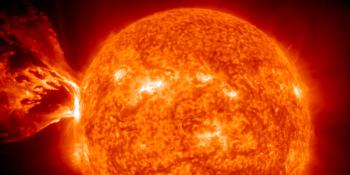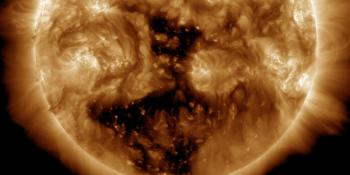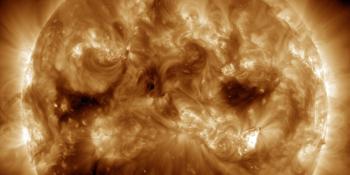Visualizzazione archivio di giovedì, 13 marzo AM
Daily bulletin on solar and geomagnetic activity from the SIDC
Emesso: 2025 Mar 13 1231 UTC
SIDC Forecast
Brillamenti solari
M-class flares expected (probability >=50%)
Geomagnetism
Active conditions expected (A>=20 or K=4)
Protoni solari
Quiet
| 10cm flux | Ap | |
|---|---|---|
| 13 Mar 2025 | 165 | 024 |
| 14 Mar 2025 | 167 | 007 |
| 15 Mar 2025 | 168 | 007 |
Solar Active Regions and flaring
Solar flaring activity was low over the past 24 hours, with only C-class flares identified. The largest flare was a C6.8 flare (SIDC Flare 3823) peaking on March 13 at 07:52 UTC, which was produced by SIDC Sunspot Group 423 (NOAA Active Region 4012). A total of 11 numbered sunspot groups were identified on the disk over the past 24 hours. SIDC Sunspot Group 428 (NOAA Active Region 4019) and SIDC Sunspot Group 398 (NOAA Active Region 4021) have the most complex magnetic configuration (Beta_Delta). SIDC Sunspot Group 405 (NOAA Active Region 4028) has turned on disk on the east limb and was responsible for most of the C-class flaring over the past 24h. Solar flaring activity is expected to be moderate over the next 24 hours, with M-class flares likely and a small chance for X-class flares.
Espulsioni di massa coronale
No new Earth-directed Coronal Mass Ejections (CMEs) have been detected in the available coronagraph images.
Vento solare
In the last 24 hours, Earth was under the influence of the high speed stream (HSS) from the negative polarity coronal hole which crossed the central meridian on March 10. The solar wind speed increased to 560 km/s. The interplanetary magnetic field reached 12 nT and now gradually reduced to 7 nT. The North-South component (Bz) reached minimum value of -9 nT. In the next 24 hours, we expect a gradual transition from fast to slow solar wind.
Geomagnetism
Geomagnetic conditions were at minor storm levels globally (Kp 5) and active conditions locally (K Bel 4) since mid of March 12 due to a high-speed stream arrival. Unsettled to active conditions are expected in the next 24 hours.
Proton flux levels
The greater than 10 MeV proton flux remained below the 10 pfu threshold and is expected to remain so over the next days.
Electron fluxes at geostationary orbit
The greater than 2 MeV electron flux was above the 1000 pfu threshold on March 12, but are currently below the threshold. The greater than 2 MeV electron flux is expected to be high and occasionally above the 1000 pfu threshold in the upcoming days. The 24h electron fluence was at nominal level and is expected to remain so in the next days.
Today's estimated international sunspot number (ISN): 164, based on 14 stations.Solar indices for 12 Mar 2025
| Wolf number Catania | /// |
| 10cm solar flux | 160 |
| AK Chambon La Forêt | 046 |
| AK Wingst | 029 |
| Estimated Ap | 035 |
| Estimated international sunspot number | 158 - Based on 15 stations |
Noticeable events summary
| Day | Begin | Max | Fine | Loc | Strength | OP | 10cm | Catania/NOAA | Radio burst types | |
|---|---|---|---|---|---|---|---|---|---|---|
| Nessuna | ||||||||||
Provided by the Solar Influences Data analysis Center© - SIDC - Processed by SpaceWeatherLive
Tutti gli orari in UTC
<< Vai alla pagina della panoramica giornaliera
Ultime notizie
Ultimi messaggi dal forum
Supporta SpaceWeatherLive.com!
Molte persone vengono su SpaceWeatherLive per seguire l'attività del Sole o sapere se ci sia la possibilità di vedere l'aurora, ma a maggior traffico corrispondono costi maggiori. Considerate una donazione se vi piace SpaceWeatherLive così che possiamo mantenere online il sito web!

Notizie sul meteo spaziale
| Ultimo brillamento X | 2025/03/28 | X1.1 |
| Ultimo brillamento M | 2025/04/01 | M2.5 |
| Ultima tempesta geomagnetica | 2025/04/04 | Kp5+ (G1) |
| Giorni senza macchie | |
|---|---|
| Ultimo giorno senza macchie | 2022/06/08 |
| Media mensile Numero di Macchie Solari | |
|---|---|
| marzo 2025 | 134.2 -20.4 |
| aprile 2025 | 148 +13.8 |
| Ultimi 30 giorni | 130.9 -15.2 |


